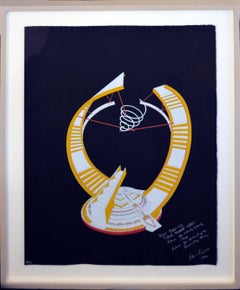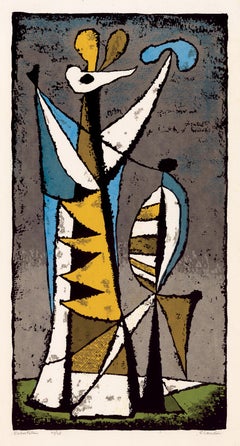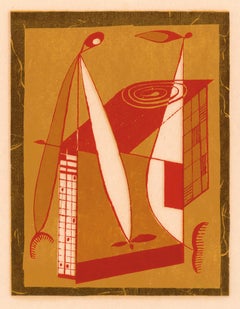Alice Aycock Art
American, b. 1946
Alice Aycock studied in the late 1960s under minimalist pioneer Robert Morris, and soon thereafter began working on large-scale sculptures in wood and stone. In the 1980s, she began using steel and produced massive installations that challenged ideas of industrial aesthetics. She recently made headlines for “Paper Chase,” her series of monumental, ribbon-esque pieces along Park Avenue in Manhattan. Her steel works often appear to have transcended the laws of gravity, floating like tops above the otherwise-mundane grounds of public spaces and institutions. Aycock’s work breathes life into artificial environments, bringing playful shifts of perception wherever they are installed.to
1
Overall Width
to
Overall Height
to
1
1
1
1
1
1
1
1
7,820
5,167
2,504
1,501
1
1
Artist: Alice Aycock
Vintage Silkscreen Abstract -- The Wheely Whirly Steps
By Alice Aycock
Located in Soquel, CA
Expressive vintage silkscreen on black paper by Alice Aycock (American, 20th Century). Hand signed and dated "Alice Aycock 1990" with hand written ...
Category
1990s American Modern Alice Aycock Art
Materials
Screen, Laid Paper
Related Items
'Exhortation' (Priest) — Mid-Century Modernism
By Edward August Landon
Located in Myrtle Beach, SC
Edward Landon 'Exhortation (Priest)', color serigraph, 1957, edition 28, Ryan 72. Signed, titled, and numbered '21/28' in pencil. A superb, richly-inked impression, with strong color...
Category
Mid-20th Century American Modern Alice Aycock Art
Materials
Screen
'Chinoiserie' — Mid-Century Modernism
By Edward August Landon
Located in Myrtle Beach, SC
Edward Landon 'Chinoiserie', color serigraph, 1947, edition 50, Ryan 36. Signed in pencil in the image, lower right. Titled, dated, and annotated '4 COLORS – EDITION 50' in the scree...
Category
Mid-20th Century American Modern Alice Aycock Art
Materials
Screen
The Fan
By Leonard Pytlak
Located in Fairlawn, OH
The Fan
Silkscreen printed in colors, 1950's
Signed and numbered in pencil by the artist (see photos)
Edition: 40 (24/40)
Condition: very good
Image size: 25 1/8 x 19 5/8 inches
Cou...
Category
1950s American Modern Alice Aycock Art
Materials
Screen
He Repeated the Letters of the Alphabet
By Corita Kent
Located in Missouri, MO
Sister Mary Corita Kent (American, 1918-1986)
He Repeated the Letters of the Alphabet...
Color Screenprint
22.5 x 38.75 inches
Signed Lower Right
Sister Mary Corita Kent, once the n...
Category
Mid-20th Century American Modern Alice Aycock Art
Materials
Color, Screen
JOSEF ALBERS, Homage to the Square (diptych), 1971
By Josef Albers
Located in Torino, IT
JOSEF ALBERS, Bottrop 1888 - New Haven 1976
Homage to the Square (diptych), 1971
Original colored serigraph.
Perfect copies published in 1971 by the Ives-Sillman Inc. edition, New Ha...
Category
1970s American Modern Alice Aycock Art
Materials
Screen
Anthony Velonis, Exhibit, Small Sculpture
By Anthony Velonis
Located in New York, NY
Anthony Velonis (1911-1997) was an extremely innovative artist. He learned the technique of screen printing, also known as silkscreen, (for which he also coined the term serigraphy) while working with a wall paper manufacturer.
Unusual for fine prints, the image is made by the artist in the same direction as it will print, as the colored inks are forced through fabric (silk) directly onto a paper surface. (He also invented a machine that could print onto column-shaped items such as cocktail glasses or make-up bottles and a rack system for drying sheets of paper with wet ink in which the sheets are just inches apart.)
The technique allows extreme versatility on the part of the artist and the ink tends to sit on top of the paper rather than soak into the fibers. In 1934 Velonis used this new technique on Mayor LaGuardia's NYC Poster...
Category
Mid-20th Century American Modern Alice Aycock Art
Materials
Screen
Eggbeater 1: 34 Square inch Limited Edition Silk Scarf, for the Whitney Museum
By Stuart Davis
Located in New York, NY
Stuart Davis
Eggbeater No. 1 Silk Scarf, ca. 1980
100% silks scarf
34 × 34 inches (the smaller measurements shown are after the scarf is folded, to minimize shipping costs, as it sh...
Category
Mid-20th Century American Modern Alice Aycock Art
Materials
Silk, Screen
1930s Modernist Print by Hilaire Hiler: Indian with Bow in Fox Costume Artwork
By Hilaire Hiler
Located in Denver, CO
This vintage 1934 color serigraph (silkscreen print) by Hilaire Hiler (1898-1966) depicts a Native American figure dressed in a fox costume and holding a bow, showcasing a stylized feather headdress and bold black, red, and white color contrasts. Created during the WPA era, this modernist print reflects Hiler's semi-abstract approach to Native American themes. The print is pencil signed by the artist in the lower right margin and titled on the verso.
About the Artist, Hilaire Hiler:
Hilaire Hiler was an influential New Mexico artist known for his modernist style and exploration of Native American subjects. Born in St. Paul, Minnesota, Hiler studied at prestigious art institutions such as the University of Paris and Pennsylvania Academy of the Fine Arts before moving to Paris in 1919. Hiler was active in the European avant-garde scene, supporting himself as a jazz musician.
In 1934, he returned to America, where he was commissioned by the Works Progress Administration (WPA) to create murals for the Aquatic Park...
Category
1930s American Modern Alice Aycock Art
Materials
Screen
H 17.5 in W 15 in D 1.5 in
"Season's Greetings, " Abstract Holiday Silkscreen signed by Schomer Lichtner
By Schomer Lichtner
Located in Milwaukee, WI
"Season's Greetings" is an original color silkscreen by Schomer Lichtner. The artist signed the piece in the screen on verso. This piece features abstract, linear patterns in blue and white on a brown paper background.
6 1/4" x 4 5/8" art
14" x 12 1/2" frame
Milwaukee artist, Schomer Lichtner passed away on May 9, 2006 at the age of 101. He continued to amaze and create with his whimsical paintings of ballerinas and cows. He and his late wife Ruth Grotenrath, both well-known Wisconsin artists, began their prolific careers as muralists for WPA projects, primarily post offices.
Schomer Lichtner was well known for his whimsical cows and ballerinas, such as his "Ballerina Dancing on Cow" sculpture below. The late James Auer, art critic for the Milwaukee Journal Sentinel referred to Lichtner as the artist laureate of Milwaukee, Wisconsin. He was the official artist of the Milwaukee Ballet.
Lichtner also painted murals for industry and private clients. Schomer was a printmaker and produced block prints, lithographs, and serigraph prints. His casein (paint made from dairy products) and acrylic paintings are of the rural Wisconsin landscape and farm animals. He became interested in cows when he and Ruth spent summers near Holy Hill in Washington County.
According to David Gordon, director of the Milwaukee Art Museum, Schomer Lichtner had a tremendous joie de vivre, " joy of life," and expressed it in his art.
Schomer Lichtner was nationally known for his whimsical paintings and sculptures of black- and white-patterned Holstein cows and elegant ballerina dancers. Lichtner also painted all sorts of combinations of beautiful women, flowers and country landscapes. James Auer, former Milwaukee Journal Sentinel art critic, said that his art eventually "exploded into expressionistic design elements with bold, flat areas of color and high energy that anticipated Pop Art." Auer went on to describe Lichtner’s work as full of "wit, vigor and virtuosity."
As early as 1930, Lichtner’s work was shown at the prestigious Carnegie International Exhibition in New York and at museums throughout the Midwest. As a student, he was a protégé of another icon of 20th century American art, Gustave Moeller...
Category
1950s American Modern Alice Aycock Art
Materials
Screen
"Indianapolis Museum of Art Inaugural Exhibitions", Color Silkscreen, Signed
By Robert Indiana
Located in Detroit, MI
"Indianapolis Museum of Art Inaugural Exhibitions", 25 October 1970, is an eye popping large bold colorful geometric abstract silk screen. It is signed on the lower right.
Robert Indiana, one of the preeminent figures in American art since the 1960s, played a central role in the development of assemblage art, hard-edge painting, Pop art, Neo-Dada, American Modernism and Modern Art. A self-proclaimed “American painter of signs,” Indiana created a highly original body of work that explores American identity, personal history, and the power of abstraction and language, establishing an important legacy that resonates in the work of many contemporary artists such as Andy Warhol, Keith Haring, Roy Lectenstein, David Hockney, Romero Britto, Richard Hamilton and Robert Rauschenberg who make the written word a central element of their oeuvre.
Robert Indiana was born Robert Clark in New Castle, Indiana on September 13, 1928. Adopted as an infant, he spent his childhood moving frequently throughout his namesake state. At 14 he moved to Indianapolis in order to attend Arsenal Technical High School, known for its strong arts curriculum. After graduating he spent three years in the U.S. Air Force and then studied at the Art Institute of Chicago, the Skowhegan School of Sculpture and Painting in Maine, and the Edinburgh College of Art in Scotland.
In 1956, two years after moving to New York, Indiana met Ellsworth Kelly, and upon his recommendation took up residence in Coenties Slip, where a community of artists that would come to include Kelly, Agnes Martin, James Rosenquist, and Jack Youngerman had studios. Indiana, like some of his fellow artists, scavenged the area’s abandoned warehouses for materials, creating sculptural assemblages from old wooden beams, rusted metal wheels, and other remnants of the shipping trade that had thrived in Coenties Slip. The discovery of 19th century brass stencils led to the incorporation of brightly colored numbers and short emotionally charged words onto these sculptures as well as canvases, and became the basis of his new painterly vocabulary.
Although acknowledged as a leader of Pop, Indiana distinguished himself from his Pop peers by addressing important social and political issues and incorporating profound historical and literary references into his works. In 1964 Indiana accepted Philip Johnson’s invitation to design a new work for the New York State Pavilion at the New York World’s Fair, creating a 20-foot EAT sign...
Category
1970s American Modern Alice Aycock Art
Materials
Paper, Ink, Screen
Modernist Figurative Pop Art Etching and Aquatint "the Artist" Michael Mazur
By Michael Mazur
Located in Surfside, FL
Michael Mazur
"The Artist"
Hand signed and editioned from the edition of 50
1967
Michael Burton Mazur (1935-August 18, 2009) was an American artist who was described by William Grim...
Category
Early 2000s American Modern Alice Aycock Art
Materials
Lithograph, Screen
Coxuria, from The Geldzahler Portfolio
By Frank Stella
Located in London, GB
Screenprint in colours, 1997, on White Lana mouldmade paper, signed and dated in pencil, 69th from edition of 75 (there were also 15 artist’s proofs), printed by Tyler Graphics, Ltd....
Category
1990s American Modern Alice Aycock Art
Materials
Screen
Alice Aycock art for sale on 1stDibs.
Find a wide variety of authentic Alice Aycock art available for sale on 1stDibs. If you’re browsing the collection of art to introduce a pop of color in a neutral corner of your living room or bedroom, you can find work that includes elements of blue and other colors. You can also browse by medium to find art by Alice Aycock in digital print, inkjet print, paint and more. Much of the original work by this artist or collective was created during the 21st century and contemporary and is mostly associated with the abstract style. Not every interior allows for large Alice Aycock art, so small editions measuring 18 inches across are available. Customers who are interested in this artist might also find the work of William Jacobs, Mark di Suvero, and Daisy Craddock. Alice Aycock art prices can differ depending upon medium, time period and other attributes. On 1stDibs, the price for these items starts at $1 and tops out at $2,280, while the average work can sell for $1.


